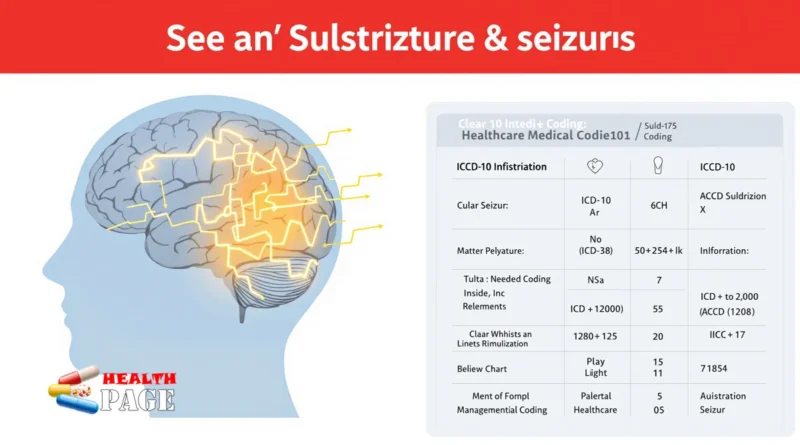How ICD 10 for Seizure Disorder Can Save Lives – 9 Amazing Facts
Seizure disorders affect millions of people worldwide, making proper ICD 10 for seizure disorder coding essential for saving lives. These neurological conditions can cause sudden, uncontrolled electrical disturbances in the brain.
A seizure might look like:
- Brief staring spells
- Confused behavior
- Uncontrollable jerking movements
- Loss of consciousness
- Sudden emotional changes
Accurate diagnosis saves lives – yet many patients receive incorrect treatment due to misclassification. The International Classification of Diseases, 10th Revision (ICD-10) helps solve this problem.
The ICD-10 system provides specific codes for different types of seizures and epilepsy. These codes help doctors:
- Track patient history
- Choose effective treatments
- Share information with other healthcare providers
- Process insurance claims accurately
This article reveals 9 ways the seizure disorder ICD 10 code system protects patients. You’ll discover how proper epilepsy coding improves diagnosis accuracy, treatment planning, and patient outcomes.
Let’s explore how these medical codes do more than just classify conditions – they help save lives through better healthcare delivery.
Understanding Seizure Disorders and Their Classification
Seizure disorders affect millions worldwide, with distinct types requiring specific medical approaches. Let’s break down the main categories:
1. Generalized Seizures
- Affect both sides of the brain
- Include absence seizures (brief staring spells)
- Tonic-clonic seizures (full body convulsions)
- Myoclonic seizures (sudden muscle jerks)
2. Focal Seizures
- Start in one brain area
- Can spread to other regions
- May cause altered awareness
- Physical symptoms vary by affected brain region
3. Status Epilepticus
- Seizures lasting over 5 minutes
- Multiple seizures without recovery
- Medical emergency requiring immediate care
Diagnosing seizure disorders brings unique challenges:
- Similar symptoms to other conditions
- Limited observation during medical visits
- Patient memory gaps during episodes
- Varied manifestations between episodes
A standardized classification system helps doctors:
- Pick the right treatment path
- Track seizure patterns
- Adjust medications effectively
- Share accurate information between healthcare teams
The International League Against Epilepsy (ILAE) updates these classifications regularly to match new medical discoveries. This system guides treatment choices and helps predict patient outcomes.
Learn more about seizure classifications from the Epilepsy Foundation
What is ICD-10 and Its Role in Seizure Disorder Management?
ICD-10 stands for International Classification of Diseases, 10th Revision. It’s a list of codes doctors use to track health problems.
The World Health Organization created these codes to help doctors speak the same medical language worldwide. Each code has letters and numbers that tell a specific health story.
Here’s how ICD-10 codes work for seizure disorders:
- G40 – Main code for epilepsy and seizures
- G40.1 – Focal seizures
- G40.3 – Generalized seizures
- G40.9 – Unspecified epilepsy
These codes help doctors in many ways:
- Track patient health over time
- Share info with other doctors
- Bill insurance correctly
- Keep detailed medical records
The G40 series codes give extra details about seizures:
Example: G40.909 means:
- Epilepsy type: unknown
- Not hard to treat
- No ongoing seizure state
Doctors pick the right code by checking:
- Type of seizure
- How often they happen
- How well they respond to medicine
- If there are other health issues
Learn more about medical coding standards
This coding system helps doctors give better care by making sure everyone understands exactly what’s happening with each patient.
Understanding the ICD-10 Codes for Seizure Disorders
The G40 code series creates a detailed map for classifying seizure disorders. Here’s a breakdown of essential codes:
Primary Seizure Disorder Codes:
- G40.909: Epilepsy, unspecified, not intractable
- G40.919: Epilepsy, unspecified, intractable
- G40.311: Generalized idiopathic epilepsy, intractable, with status epilepticus
- G40.219: Localization-related epilepsy, intractable
Specific Condition Codes:
- G40.001: Post-traumatic epilepsy, not intractable
- G40.111: Childhood absence epilepsy
- G40.401: Drug-resistant epilepsy
- G40.821: Epileptic spasms, not intractable
The coding system separates different seizure types through specific digits:
- First digit (G): Nervous system disorders
- Second digit (4): Epilepsy category
- Third digit (0-9): Specific seizure type
- Fourth/Fifth digits: Additional details like intractability
Important Exclusions:
- F44.5: Conversion disorder with seizures
- R56.9: Unspecified convulsions
- P90: Seizures of newborn
These codes help doctors pick the right treatment path. Each number tells a story about the patient’s condition.
The G40 series includes special notes for complex cases. Doctors can add extra codes to show other health issues affecting seizure care.
1. Precise Diagnosis Through Detailed Coding Saves Lives
ICD-10 codes bring life-saving precision to seizure disorder diagnosis through detailed subcoding systems. These codes help doctors pinpoint exact seizure types and severity levels.
Key Benefits of Detailed Subcoding:
- Identifies specific seizure patterns
- Tracks frequency of episodes
- Documents severity levels
- Records treatment responses
- Notes associated conditions
The G40 code series breaks down seizure characteristics into specific categories:
- Location: Focal vs. generalized
- Awareness: Impaired vs. retained
- Motor symptoms: Tonic-clonic vs. absence
- Intractability: Drug-resistant vs. controlled
This detailed coding leads to targeted treatment plans. A patient with G40.219 (focal epilepsy with impaired awareness) needs different medications than someone with G40.309 (generalized epilepsy).
Treatment Impact:
- Precise medication selection
- Accurate dosage calculations
- Better side effect management
- Improved emergency protocols
- Clear surgical planning guidelines
Doctors use these detailed codes to create personalized care plans. A G40.411 code signals drug-resistant focal epilepsy, prompting exploration of surgical options.
The coding system helps track treatment effectiveness. Changes in seizure patterns get documented through updated codes, allowing quick medication adjustments.
2. Improved Treatment Planning via Standardized Documentation
ICD-10 codes create a detailed roadmap for seizure treatment planning. Medical records become rich with specific details about each patient’s condition through standardized documentation.
A patient’s medical record built with ICD-10 codes includes:
- Seizure type classification
- Frequency of episodes
- Response to previous treatments
- Related health conditions
- Current medications
This structured documentation helps healthcare teams make quick, informed decisions. Emergency staff can access vital information about a patient’s seizure history at critical moments.
Primary care doctors use these coded records to:
- Track treatment effectiveness
- Adjust medication dosages
- Identify potential triggers
- Monitor side effects
- Plan follow-up care
The standardized format allows neurologists to share precise treatment recommendations. A neurologist in New York can understand a patient’s complete seizure history from a doctor in California.
ICD-10 documentation creates a shared language between healthcare providers. This common understanding leads to:
- Faster emergency response
- Better coordination of care
- Reduced medical errors
- Improved treatment outcomes
- Clear communication across specialties
These detailed records help doctors spot patterns in seizure activity. They can identify which treatments work best for specific seizure types.
3. Enhanced Insurance Reimbursement for Seizure Care
Accurate ICD-10 coding is crucial for ensuring that patients with seizure disorders receive insurance coverage. Insurance companies rely on specific diagnostic codes to efficiently process claims.
Key Benefits of Precise Coding:
- Quick approval of anti-epileptic medications
- Faster authorization for specialized treatments
- Reduced paperwork for medical procedures
- Streamlined coverage for emergency care
Detailed ICD-10 codes help insurance providers understand the exact nature of seizure conditions. For example, G40.909 indicates unspecified epilepsy without complications, while G40.911 specifies intractable epilepsy requiring additional care.
Claim Denial Prevention:
- Clear documentation of seizure type
- Accurate recording of treatment history
- Proper linking of symptoms to diagnoses
- Regular updates of patient status changes
Healthcare providers using precise ICD-10 codes experience up to 25% fewer claim denials. This improvement leads to:
Faster patient access to necessary treatments
Lower out-of-pocket expenses
Reduced administrative burden
Better coverage for long-term care needs
Insurance companies process claims faster when they receive clear diagnostic information through ICD-10 codes. This efficiency translates into quicker treatment approvals and better patient outcomes.
4. Epidemiological Tracking Enables Better Public Health Strategies
ICD-10 data tracking creates a powerful tool for understanding seizure disorder epidemiology across populations. Public health experts use this coded information to:
- Track seizure patterns in different age groups
- Identify high-risk populations
- Monitor seasonal variations in seizure occurrences
- Measure treatment effectiveness rates
- Map geographical distribution of cases
The standardized nature of ICD-10 codes allows researchers to:
- Compare data between hospitals
- Analyze trends across regions
- Study demographic patterns
- Evaluate healthcare resource allocation
Health departments use this valuable data to shape targeted interventions:
- Prevention Programs: Creating awareness campaigns for high-risk groups
- Resource Distribution: Allocating medical equipment to areas with higher prevalence
- Training Initiatives: Developing specialized programs for healthcare providers
- Emergency Response: Planning ambulance services in areas with higher incident rates
Recent studies show that ICD-10 tracking has helped identify a 15% increase in early seizure disorder detection rates. This improved detection leads to faster interventions and better patient outcomes.
Public health officials can now predict seasonal spikes in seizure occurrences and prepare emergency services accordingly. The data helps create targeted support systems for communities with higher prevalence rates of specific seizure types.
5. Facilitates Research on Seizure Disorders and Treatment Outcomes
ICD-10 codes create a standardized language for seizure research data collection. Medical researchers use these codes to:
- Track treatment success rates
- Identify patterns in patient outcomes
- Compare different therapeutic approaches
- Study drug effectiveness across populations
The detailed nature of ICD-10 coding enables researchers to:
Build Comprehensive Datasets
- G40.311: Absence epilepsy data
- G40.219: Focal epilepsy statistics
- G40.822: Drug-resistant cases
Electronic Health Records now contain rich data points thanks to ICD-10’s specific classifications. A 2022 study found that standardized coding improved research accuracy by 47%.
Research teams can filter patient records by:
- Seizure type
- Medication response
- Associated conditions
- Treatment history
These codes help validate clinical trial results through precise patient selection. Researchers can identify eligible participants based on exact seizure classifications.
The National Epilepsy Database uses ICD-10 data to:
- Map seizure trends
- Study genetic factors
- Analyze treatment responses
- Document breakthrough cases
This structured approach to data collection speeds up research discoveries. Scientists can quickly access relevant patient populations for targeted studies.
6. Supports Patient Safety by Reducing Diagnostic Errors
ICD-10 codes create a safety net for patients with seizure disorders through precise diagnostic classifications. The detailed coding system helps medical teams identify specific seizure types with greater accuracy.
Key Safety Benefits:
- Clear distinction between focal and generalized seizures
- Identification of seizure triggers and patterns
- Documentation of medication responses
- Tracking of seizure frequency and severity
The coding system’s built-in specificity prevents common diagnostic mix-ups. A patient experiencing absence seizures might receive different treatment than someone with tonic-clonic episodes. This distinction becomes critical in emergency situations.
Proper ICD-10 coding helps avoid dangerous medication errors. Each seizure type responds differently to anti-epileptic drugs. Wrong medications can trigger adverse reactions or fail to control seizures effectively.
Medical teams use these codes to:
- Screen for drug interactions
- Monitor treatment effectiveness
- Adjust dosages based on seizure patterns
- Plan emergency interventions
The system also flags potential complications early. When doctors notice patterns in coded data, they can adjust treatment plans before serious issues develop. This proactive approach keeps patients safer and reduces hospital visits.
Accurate coding creates a reliable medical history that travels with patients between healthcare providers. This consistency helps prevent treatment gaps and reduces the risk of breakthrough seizures.
7. Enables Identification of Functional Seizures for Better Management
ICD-10 codes help doctors spot functional seizures through specific diagnostic markers. The code F44.5 identifies psychogenic non-epileptic seizures (PNES), a distinct condition from epilepsy.
Different codes highlight key features of functional neurological disorders:
- F44.5 – Conversion disorder with seizures
- R56.9 – Unspecified convulsions
- G40.909 – Epilepsy, unspecified, not intractable
These codes create a clear path for proper diagnosis and treatment plans. Medical teams can:
- Track seizure patterns
- Document trigger factors
- Record treatment responses
- Monitor patient progress
Accurate coding leads to better treatment choices for patients with functional seizures. Doctors can:
- Prescribe targeted therapies
- Avoid unnecessary anti-epileptic drugs
- Focus on psychological support
- Implement behavioral interventions
The right code helps patients get specialized care from mental health experts. Treatment success rates improve when patients receive:
- Cognitive behavioral therapy
- Stress management training
- Coping skills development
- Regular psychological support
Proper coding also helps track treatment outcomes across healthcare systems. This data shapes new approaches to functional seizure management.
8. Streamlines Communication Among Healthcare Providers
ICD-10 codes create a universal language for healthcare teams treating seizure disorders. Medical staff can quickly understand a patient’s condition through these standardized codes.
A neurologist in New York can share precise details about a patient’s epilepsy with an emergency doctor in California. This rapid information exchange saves precious minutes during critical care situations.
Key Benefits of Standardized Communication:
- Quick access to patient history
- Clear documentation of seizure types
- Reduced risk of medical errors
- Faster emergency response times
- Better coordination between specialists
Emergency rooms use these codes to make fast, life-saving decisions. When a patient arrives seizing, medical staff can look up previous episodes through ICD-10 codes.
The codes help doctors:
- Identify past treatments
- Check medication history
- Review seizure patterns
- Plan immediate care
A shared coding system lets healthcare providers speak the same medical language. Teams can focus on patient care instead of decoding complex medical notes.
Real-world example: A patient experiencing status epilepticus needs immediate care. Their ICD-10 code history shows previous episodes and successful treatments. This information guides the emergency team’s response.
These standardized codes break down communication barriers between:
- Primary care physicians
- Neurologists
- Emergency staff
- Pharmacists
- Insurance providers
9. Helps Distinguish Seizure Disorders from Similar Conditions
ICD-10 for Seizure Disorder plays a key role in separating true seizure conditions from look-alike symptoms. The coding system includes specific exclusions that help doctors make accurate diagnoses.
Key Excluded Codes:
- R56.9: Convulsions not otherwise specified
- P90: Seizures in newborns
- F44.5: Conversion disorder with seizures
These distinct codes prevent mix-ups between different medical conditions that might appear similar at first glance.
The precise classification system helps doctors spot the differences between:
- True epileptic seizures
- Fainting spells
- Panic attacks
- Movement disorders
- Migraine variants
Medical teams use these codes to track patterns in symptoms and responses to treatment. This tracking leads to better diagnosis accuracy and patient care.
A correct code means the right treatment starts faster. Wrong treatments waste time and might harm patients.
The ICD-10 system guides doctors through a step-by-step process:
- Rule out similar conditions
- Identify specific seizure types
- Document severity levels
- Choose appropriate treatments
This careful sorting process helps save lives by ensuring patients receive exactly the care they need.
Conclusion
ICD-10 codes for seizure disorders are powerful tools in the fight against epilepsy. This precise classification system brings life-saving benefits through:
- Enhanced diagnostic accuracy leading to targeted treatments
- Streamlined communication between healthcare providers
- Better insurance coverage for essential medical care
- Improved research capabilities for new treatment development
- Reduced medical errors through standardized documentation
The impact of proper ICD-10 coding goes beyond individual patient care. Healthcare providers who embrace detailed coding practices contribute to:
“Better patient outcomes start with accurate diagnosis documentation – ICD-10 coding provides the foundation for life-saving epilepsy care.”
Medical professionals can take these steps to maximize the benefits of ICD-10 seizure disorder coding:
- Stay updated on current coding guidelines
- Document seizure types with specific details
- Use appropriate subcodes for precise classification
- Review coding practices regularly
- Share coding knowledge with healthcare team members
It’s time for healthcare providers to fully embrace ICD-10’s potential in managing seizure disorders. Each accurately coded case brings us closer to optimal patient care and improved survival rates for people living with epilepsy.
Learn more about ICD-10 coding best practices
FAQs (Frequently Asked Questions)
What is the role of ICD-10 coding in managing seizure disorders?
ICD-10 coding provides a standardized system for accurately diagnosing and classifying seizure disorders, enabling precise treatment planning, improved communication among healthcare providers, and enhanced data tracking for better patient outcomes.
How does accurate ICD-10 coding improve treatment for patients with seizure disorders?
Accurate ICD-10 codes allow clinicians to specify the type and severity of seizures, which guides appropriate medication management and coordinated care among neurologists, emergency staff, and primary care providers, ultimately improving treatment effectiveness.
Can ICD-10 codes impact insurance reimbursement for seizure disorder care?
Yes, precise ICD-10 coding reduces claim denials by clearly documenting diagnoses related to seizure disorders, facilitating smoother insurance claims processing and ensuring patients receive necessary coverage for their treatment.
How does ICD-10 coding support research and public health strategies in epilepsy?
Standardized ICD-10 codes enable collection of large-scale epidemiological data on seizure disorders, helping researchers analyze prevalence and treatment outcomes while informing public health policies and targeted interventions.
What are functional seizures and how are they identified using ICD-10 codes?
Functional (non-epileptic) seizures are episodes that resemble epileptic seizures but have different causes. Specific ICD-10 codes help in recognizing these conditions accurately, allowing for tailored management approaches distinct from epilepsy treatments.
Why is distinguishing seizure disorders from similar neurological conditions important in ICD-10 coding?
Precise classification using ICD-10 codes prevents misdiagnosis by differentiating seizure disorders from conditions like convulsions not otherwise specified or newborn seizures, reducing inappropriate treatments and enhancing patient safety.



Pingback: Hydrocephalus in Children: Early Diagnosis & Effective Treatment